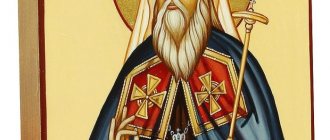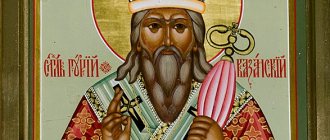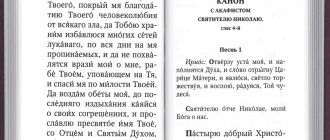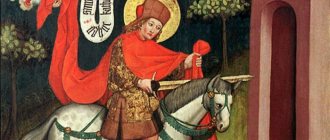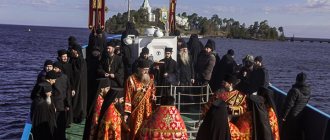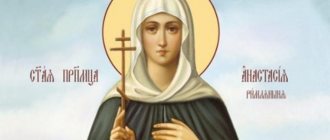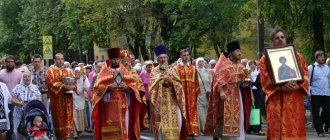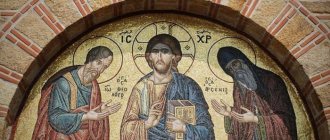Biography and origin
In 1505, in the city of Staritsa, which is located on the banks of the Volga River, a boy was born - Grigory Sadyrev-Polev. His father, Fyodor Afanasyevich, came from an ancient Smolensk princely family. The pious nobleman gave the name to his son in honor of the Christian ascetic - St. Gregory Dekapolite.
From childhood, Gregory's parents raised him in severity and modesty. He grew up meek and gifted; instead of playing games, he loved to study the Divine Scripture, indulge in prayers, and read the psalms of David.
Biography of the saint
From an early age, parents took their son to Divine services, and the whole family strictly observed fasts. Gregory was so zealous in abstaining from food that his relatives feared for his health. The boy’s soul yearned for silence, tranquility, solitude, and service to the One God. Therefore, his natural need was the desire to take monastic vows, which he did at the age of 25 in the Joseph-Volokolamsk Monastery.
Father and mother blessed Gregory to become a monk. The ceremony was performed by Abbot Gury. Since then, the young man was named Herman. Fyodor Afanasyevich soon entered service at the monastery in the same way, took the name Philofey and served as cellarer and treasurer. In 1530-1531, he donated the village of Redkino, which was his property, to the monastery.
In the monastery, the future Saint Herman copied spiritual books. Here fate brought him together with the innocently imprisoned blessed Maxim the Greek.
Rumors about Herman's virtues reached his hometown of Staritsa. In 1551 he received the rank of archimandrite of the Staritsky Assumption Monastery. Soon, in 1554, a Council Court was convened in Moscow, at which the case of the heretic and reformer Matvey Semenovich Bashkin was examined. By the decision of the Council, he was assigned exile to the Volokolamsk Monastery, and Saint Herman accompanied the condemned man. In this monastery he remained treasurer.
The former abbot of the Volokolamsk monastery, Gury, had by that time arrived in Kazan, where he was elevated to the archbishop's see. Tsar Ivan Vasilyevich the Terrible intended to spread faith in Christ to the conquered territory of the Tatar Kazan kingdom. For this purpose, in Sviyazhsk, a district town in the Kazan province, located on the Sviyaga River, it was decided to build a monastery.
Saint Gury called for the construction of Herman, and in 1555 they met in Sviyazhsk. Herman became the rector of the monastery and put a lot of effort into the construction of the St. Nicholas Church, the Church of the Assumption of the Mother of God. The associate himself huddled in a narrow cell, indulged in prayers in it, and helped everyone who turned to him with requests. He not only led the brethren, but also succeeded in edifying the parishioners.
In 1564, Saint Gury of Kazan passed away. Herman was elected as the successor of his good work, Archbishop of Kazan and Sviyazhsk. Despite such a high position, the saint remained a simple, open and sincere person, devoid of guile and hypocrisy. He became a worthy successor to the exploits and virtues of his predecessor.
Archbishop of Kazan and Sviyazhsk
On December 5, 1563, after many labors and exploits, High Hierarch Guriy of Kazan gave up his soul to the Lord. Tsar Ivan Vasilyevich the Terrible and Metropolitan Athanasius of Moscow summoned Herman to Moscow, wanting to elevate him to the archpastoral throne in Kazan. “They had already heard a lot about the zeal of this holy man and saw in him the only worthy successor to Saint Guria.”
Archbishop Herman, summoned by a conciliar letter to Moscow, at first refused, but then had to yield to the demands of the tsar and the Consecrated Council. On March 12, 1564, he was ordained Archbishop of Kazan and Sviyazhsk. “Ruling his flock, he steadily walked in the footsteps of his great teacher and mentor, Saint Guria.” He was especially zealous about spreading the Christian faith. To do this, he introduced a hostel in the Zilantov Monastery (Zilantov Holy Dormition Monastery, located in the city of Kazan on Zilantova Mountain) in order to increase the number of monks in this monastery and expand the school for children of foreigners.
Zilantov monastery. Lithograph, 1832
It is interesting that a review of Herman was left by one of his contemporaries, Prince Kurbsky Andrei Mikhailovich (1528-1583), famous in Russian history, who later immigrated to the West: “Herman was a man of noble family, not so much tall in body as in mind, an honest husband and holy life, a student of the Holy Scriptures and a zealot for God in spiritual matters; “He was not involved in any evil custom or hypocrisy, but he was a simple, true, unshakable man, a great helper to those overwhelmed by troubles and misfortunes and very merciful to the poor.”
Opening of the cell of St. Herman
In June 2022, in memory of St. Herman of Kazan, a memorial cell was opened in the Sviyazhsk Monastery. By this time, restoration work had been completed at the monastery, which lasted ten years.
The small room contains the history of one of the periods of the saint’s life. It housed a stove, and light came through a small window. Here Herman Kazansky led a modest lifestyle, even mending his own clothes. He devoted most of his time to communicating with God. Over the years, no personal belongings of the saint remained in the cell; the surviving relic - the bishop's miter of St. Herman - is now kept in the museum of the city of Kazan.
Christian pilgrims visited the cell before. Before the revolution of 1917, the Grand Duchess of the reigning house of the Romanovs, Elisaveta Feodorovna (Elizabeth Feodorovna), visited here.
Restorers promise to furnish the premises in the historical style of the 16th century.
The dying feat of Saint Herman
In 1556, Metropolitan Athanasius of Moscow and All Rus' “due to great weakness” left his post. One of the candidates, at the behest of Ivan Vasilyevich the Terrible, was appointed to this place, Saint Herman. He did not want to take this honorable position, but was forced to agree. The righteous man used his position to point out to the tsar his injustice, force him to sincerely repent, and abolish the oprichnina. The Grand Duke could not tolerate such a restriction of freedom.
The ill-wishers of the guardsmen slandered St. Herman to the Terrible. Alexey Basmanov and his son were especially zealous. The Grand Duke was enraged by the saint’s accusatory speeches and expelled him from the metropolitan’s chambers.
Saint Herman remained in disgrace for two years. He wanted to go to Kazan, but was forced to remain under surveillance, practically in custody.
Herman Kazansky ended his earthly life in Moscow on November 6, 1567. At that time, a pestilence was raging. But it was not she who destroyed the saint. They say that he did not die a natural death, but that the guardsman was involved in this, who, by royal decree, cut off the head of the holy martyr.
Disgraced Shepherd
With the assistance of the saint, the St. John the Baptist Monastery was built in Kazan, which still exists today. The construction of this monastery is a visible sign of the saint’s zealous efforts for the splendor of God’s churches. In such labors the saint ruled the Kazan flock for about two years.
Forerunner Cathedral of the Ivanovo Monastery. Lithograph by André Durand, 1839
In 1566, Metropolitan Athanasius of Moscow, due to deteriorating health, refused to govern the Church. The strict ascetic life of Archbishop Herman was well known to Tsar Ivan the Terrible, and he wished Herman to take the archpastoral throne. By order of the tsar, Saint Saint Kazan was summoned to Moscow. However, at that time, Ivan IV surrounded himself with unworthy guardsmen who abused the tsar’s trust and committed injustice and oppression.
Summoned to Moscow by the will of the Tsar, Herman at first refused the burden placed on him. But the tsar did not tolerate objections, and Herman had to settle in the metropolitan’s chambers even before his ordination to the rank of metropolitan. And here his genuine archpastoral will manifested itself, which is so difficult to find in modern “princes of the church.” Seeing what injustices the king’s evil minions were causing to people, he began to notice with sorrow how much the king’s character had changed. True to his pastoral duty, he began to admonish the sovereign tsar, ask him to stop the atrocities and called for repentance.
The saint interceded for Metropolitan Philip (Kolychev), who also zealously denounced the tsar and the guardsmen. The guardsmen, having learned about this, began to tell the tsar that Herman’s denunciations were meaningless and the great ruler should not listen to them. The tsar's favorite Alexei Basmanov and his son spoke out most against the saint. All the guardsmen asked the tsar not to elevate Herman to the metropolitan see. Ivan the Terrible listened to his favorites. He ordered that it be conveyed to Herman: “You have not yet been elevated to the metropolis, and you are already taking away my freedom.”
The saint spent about two years in Moscow under disgrace. He was not allowed to go to Kazan, even though he was considered the Archbishop of Kazan. At this time he was kept under the supervision of bailiffs and in custody. But the unhypocritical denouncer of untruth was dangerous for the insidious guardsmen even in captivity. Saint Herman died in Moscow on November 6, 1567 during a pestilence, but there is an opinion that he was somehow killed by order of the Tsar.
According to the life of Saint Philip, Herman was killed in his cell by a guardsman, who cut off his head with an ax. The opening of the relics of the saint in 1922 partially confirmed this version. The description of the relics states: “his head was cut off, and in a way unusual in an ordinary execution, with two blows - one in front, cutting off the lower part, and the other on the back of the neck.” Saint Herman was buried at the Church of Saint Nicholas of the Sviyazhsk Monastery.
Miraculously surviving relics
Information about the original burial place of St. Herman differs: according to some sources, this is the Kremlin Cathedral of St. Nicholas the Wonderworker of Gostunsky, according to others, the Church of St. Nicholas the Wonderworker in Zaryadye. Unfortunately, neither one nor the other cathedral has survived to this day.
In 1595 (according to some sources, in 1592), the relics of the saint were discovered: discovered during the reconstruction of the Church of St. Nicholas the Wonderworker, examined and, with the permission of the Tsar of All Rus' Fyodor I Ivanovich, placed in the altar of the Assumption Church of the Sviyazhsk Mother of God Monastery.
All residents of Sviyazhsk greeted the relics of St. Herman with reverence and joy. On the same day, unprecedented miracles began to happen. When the holy gift was brought into the temple, everyone felt the divine fragrance. Two blind men who participated in the procession regained their sight.
A hundred years later, in 1696, the relics were examined again. Since then, the Orthodox Church has been celebrating the memory of St. Herman. In July 1704, the relics were transferred from the altar of the Assumption Church to the Assumption Church.
In 1842, a silver-gilded cypress shrine was made for the holy relics. In 1888, when placing a new miter on the head of St. Herman, the clergy confirmed that the relics remained incorrupt. They noted that there was a cut on the saint’s neck, which confirmed that his death was a martyr’s.
They say that particles were separated from the relics: in 1756, Catherine II issued a decree according to which the icon with a particle of relics was transferred to the Assumption Monastery; in 1849 such a gift was sent to the Kazan St. John the Baptist Monastery.
After the October Revolution, in 1923, like many shrines, the relics of St. Herman were opened for anti-religious propaganda. It is said that after this barbaric act a tornado arose, which forced the witnesses to flee. The Soviet government closed the monastery in 1925, and the relics were lost.
In 1929, part of the relics from the St. John the Baptist Monastery was hidden in the Yaroslavl Wonderworkers Church. In 2000, the Russian Orthodox world regained these relics, and now they are kept in the Sviyazhsk Mother of God-Uspensky and St. John the Baptist monasteries.
HERMANN
(Sadyrev-Polev Grigory Fedorovich; † 6.11.1567, Moscow), St. (memorial November 6, June 23, September 25, October 4 - in the Cathedral of Kazan Saints, on Sunday after June 29 - in the Cathedral of Tver Saints), Archbishop. Kazansky. The main sources of information about the life of the saint are the official. chronicles, acts, Kazan chronicler Joseph Krylov (BAN. 24.5.32), Volokolamsk chronicler Ignatius Zaitsev (RGB. Volok. No. 362), Life of Metropolitan. sschmch. Philip (Kolychev), Life of Saints Guria (Rugotin) of Kazan and Barsanuphius of Tver, written by Metropolitan of Kazan. sschmch. Ermogen (later Patriarch of Moscow and All Rus'), “The History of the Grand Duke of Moscow,” Prince. A. M. Kurbsky, Life of G.
St. Herman, Archbishop Kazansky. Enamel. 2nd half XIX century (GMZRK) St. Herman, Archbishop Kazansky. Enamel. 2nd half XIX century (GMZRK)
According to the book. Kurbsky, G. was “a man of light, even as Polevs are called, that gentry by birth” (Stb. 318). The Polevs traced their origins to the boyar Alexander Borisovich Pol, a descendant of the Smolensk princes. The princely title was lost by F.D. Polev, G.'s great-great-grandfather, who entered the service of the Volotsk prince. Boris Vasilievich. The Polevs had estates in Volotsk district, were connected with Joseph of Volokolamsk in honor of the Dormition of the Most Holy. Mother of God husband Mont-Rem, they took monastic vows there; their family tomb was located in Mont-Rem. (Neither G.’s father nor he himself are noted in any pedigree of the Polevs - Shokarev. P. 18-19.)
G. was the son of Sadyr (in Baptism Fedor) Polev, who had estates in Volotsky district. F.I. Polev is mentioned as a witness in the deed of sale of the village to Josephov of the Volokolamsk Monastery in 1526/27. In 1530/31 he donated the village to the Volotsk Monastery. Redkino (AFZH. T. 2. P. 95, 110-114) and at about the same time took monastic vows at the monastery with the name Philotheus. In the monastery he held the positions of cellarer (1544/45-1546/47), treasurer (1547/48 and 1552/53), in 1553/54-1554/55. was one of the cathedral elders and participated in land transactions. In 1553, Elder Philotheus led the trial of Matvey Bashkin. In 1561, G.'s father was stabbed to death under unclear circumstances.
G. Polev took monastic vows at the Joseph Volokolamsk monastery, where he was engaged in copying books under his hand. St. Guria (Rugotina). According to the monastery inventories of 1545 and 1573. 3 manuscripts created by G. are known: the Gospel, the Mother of God and the Psalter; the printed Psalter that belonged to G. was kept in the monastery (KTsDR: Joseph-Volokolamsk monastery as a center of book learning. L., 1991. P. 24, 27, 44, 57, 65, 67, 165). In the beginning. 1551 G. was appointed archimandrite of Staritsky in honor of the Dormition of the Most Holy. Mother of God husband monastery, previously was the rector of the Otmitsky (Votmitsky) monastery in honor of the Intercession of the Holy. Mother of God at the mouth of the river. Darkness near Tver. The descriptive book of the Staritsky monastery of 1607 lists G.’s numerous contributions to the monastery - “the folding images of the Savior and St. Nicholas the Wonderworker... and the folding image of the Most Pure Mother of God Hodegetria, and on the other side the saints and saints... and the panogea of the Life-Giving Trinity, and the Most Pure Incarnation... Yegor the Wonderworker on bone, covered with silver gate filigree”, icon of the martyr. Mines, silver reliquary cross (Description books of the Staritsky Assumption Monastery. P. 19). Probably, during the trial of Bashkin, G. was in Moscow, since it fell to him to accompany the condemned man to imprisonment in the Joseph Volokolamsk Monastery. G. remained there, in 1554 he was treasurer (Book of Keys. pp. 46, 51), in 1551/52, 1553/54 and 1555/56. took part in land transactions of the monastery (AFZH. Part 2. No. 236, 246, 247, 252).
St. Paul the Simple, Saints Barsanuphius of Tver, Gury and Herman of Kazan, St. Evdokia of Moscow. Icon. XX century
St. Paul the Simple, Saints Barsanuphius of Tver, Gury and Herman of Kazan, St. Evdokia of Moscow. Icon. XX century
3 Feb 1555 G. became archimandrite of the newly established Sviyazhsk in honor of the Dormition of the Most Holy. Mother of God husband mon-rya, arrived in Kazan with the archbishop. St. Kazan Guriem and Archimandrite St. Barsanuphius (later Bishop of Tver). G. was actively engaged in missionary activities, the region covered the mountainous (right bank of the Volga) side of the Kazan region (St. Barsanuphius was entrusted with the Christian education of the left bank side with Kazan). Thousands of local residents - Chuvash and Tatars - were baptized in the Sviyazhsk monastery. In 1557, when the distribution of lands abandoned by residents during the Kazan War (1552-1557) was carried out, G. achieved the allocation of large tracts of land to the mon-ru in Sviyazhsky and Kazan districts; these lands already under G. began to be developed. The Sviyazhsk monastery became the largest in the region; by the time of the secularization of church property (1764), there were approx. 60 villages and villages, more than 8 thousand revision souls lived. Under G., stone churches were erected in the monastery: in the name of St. Nicholas the Wonderworker with a bell tower and a refectory (consecrated on January 6, 1556), a cathedral in honor of the Dormition of the Most Holy. Theotokos (consecrated on September 12, 1558), which was painted with frescoes during G.'s abbotship. According to the scribe book of 1568, the library of the Sviyazhsk monastery numbered up to 152 books, of which 8 were parchment. Under G., the Sviyazhsk monastery was founded in Kazan, which turned into a con. XVI century to an independent Kazan in the name of St. John the Baptist husband mon-ry. St. Gury entrusted the Sviyazhsk archimandrite with all the rural church clergy of the Sviyazhsk district, and freed the monastery from his court.
After the death of St. Guria G. On March 12, 1564 he was elected Archbishop of Kazan. According to the Life of Saints Gurias and Barsanuphius, G. “shepherded the Church of God for three summers and eight months.” The saint spent no more than 2 years in Kazan. At this time he opened a hostel in Zilantova empty. (see Zilantov of Kazan in honor of the Dormition of the Blessed Virgin Mary, male monastery), which made it possible to increase the number of her brethren. G. spent more than a year in Moscow, where he died. The last mentions of the saint in documents date back to the spring-summer of 1566 and the beginning. 1567 April 12 1566 he vouched for the prince. M.I. Vorotynsky (SGGD. Part 1. No. 189). On Sunday, June 9 of the same year, Archbishops Pimen of Novgorod and G., together with the Rostov bishop. Nikandr served the conciliar liturgy in the Moscow Assumption Cathedral (SbRIO. 1892. T. 71. P. 364 (No. 16)). On July 2, 1566, G. signed the letter of judgment of the Zemsky Sobor on the continuation of the war with Lithuania (PSRL. T. 13. P. 402; T. 29. P. 350; Antonov. P. 172, 180), named in the chronicle under 25 July among the participants in the consecrated Council, which elected Philip (Kolychev) as Metropolitan (PSRL. T. 13. P. 403; T. 29. P. 351). (On the charter of the Zemsky Sobor, the signatures of the Novgorod Archbishop Pimen and G. are made in similar handwriting (reproduced by: Kalugin V.V. Andrei Kurbsky and Ivan the Terrible: (Theoretical views and literary technique of the ancient Russian writer). M., 1998. P. 19), on the verdict on the election of the metropolitan, the signature of G. (as well as of the Suzdal bishop. Eleutherius) is missing (SGGD. Part 1. No. 193).) Under 1566/67 (7075) G. is mentioned as a diocesan bishop in the scribe book Kazan when describing the possessions of the bishop's house (List from scribe books for the city of Kazan with the district. P. 65-70).
Cathedral of Kazan Saints: Gury, German, Barsanuphius. Icon. 2nd half XIX - early XX century
Cathedral of Kazan Saints: Gury, German, Barsanuphius. Icon. 2nd half XIX - early XX century
Sources present the circumstances of the death of the saint in different ways. According to Kurbsky, after leaving the department, Metropolitan. Athanasius (May 19, 1566) and before the erection of a shchmch on it. Philip (July 25, 1566) G. “was begged by the great prince ... that he would be the archbishop of the Russian metropolis: even though he was much forbidden from that thing, so from him (the tsar. - Author), as well as the conciliar, he was forced to this " OK. G. spent 2 days “in the metropolitan courtyard,” where he had a conversation with Tsar John IV Vasilyevich, during which the saint convinced the tsar to turn to a righteous life. After 2 days, G. was found “dead in his yard... they say strangled by his secret, at the command of him (the king - Author), but he was killed by deadly poison” (Kurbsky. Stb. 317-318). According to Kurbsky's story, G. was killed between May 19 and July 25, 1566, which is contradicted by documents indicating that the bishop was alive in the beginning. 1567. Kurbsky’s information that G.’s death was violent is confirmed by the Life of Sschmch. Philippa, according to whom G. was the only one of the bishops who came out in support of the metropolitan against the introduction of the oprichnina, convinced the tsar that in vain he was looking for false witnesses against the righteous. Soon the Kazan bishop died in his cell at the hands of the oprichnina, who was struck by two blows from an ax cut off his head. The reveiling of the relics of the saint in 1888, when a new miter was placed on his head, and the opening of the relics of G., which took place in the summer of 1922, partly confirmed the authenticity of the information given in the Life of the saint. Philip: in the description of the relics of G. o (Tver Paterik. P. 105). However, the story of the Life of Metropolitan. Philip also creates chronological difficulties, because, according to the Novgorod chronicler, the conflict between the king and Metropolitan. Philip began in March 1568, i.e. after the death of G. One might think that the death of the Kazan Archbishop was the result of some kind of conflict between him and the tsar in connection with G.’s condemnation of the oprichnina repressions. According to the Lives of Saints Guria and Barsanuphius, G. died on November 6. 1567 from pestilence. 2 Feb 1568 Lavrenty became Archbishop of Kazan.
G. was buried by the archimandrite of the Sviyazhsk monastery Herodion and the archimandrite of the Moscow Novospassky monastery Jeremiah 6 (according to other sources, 14) November. 1567, according to the will of the saint, in the Moscow church. in the name of St. Nicholas (Nikola Mokroy) in Kitay-Gorod in Zaryadye. In 1591, as a result of the reconstruction of the temple, the relics of G. were found, and miracles began to be performed from them. At the request of Kazan Metropolitan. Hermogenes, Tsar Theodore Ioannovich and Patriarch of Moscow and All Rus' St. Job was allowed to transfer the relics of the bishop to the Sviyazhsk monastery. The solemn meeting of the shrine in the monastery by the Kazan Metropolitan, the brethren of the monastery and the townspeople took place on September 25. 1592 On the same day, Metropolitan. Ermogen performed G.'s funeral service with the bishop's rite; the relics of the saint were placed in the altar of the Assumption Cathedral on the right side. The book gave a characterization of G. in his essay. Kurbsky: “As he is a man of great body, he is also a man of great mind, and a man of pure and truly holy life, and a follower of the sacred scriptures, and a zealot for God, and in many spiritual works.” According to Kurbsky, G. was “partly involved” in the teachings of St. Maxim the Greek was “a simple, true and unshakable man in reason, and was a great helper in adversity and embraced in troubles, and was also very merciful to the poor” (Kurbsky. Stb. 318-319).
G.'s life and service with miracles and funeral eulogy were written by the mon. John between 1657 and 1672 with the blessing and words of Metropolitan of Kazan. Lawrence based on the Lives of Sschmch. Philip and St. Houri. The service (5th hymn of the canon) contains testimony from Metropolitan. Lawrence about his healing through prayers to G. G.’s life is not very informative, in it the saint is especially glorified as the founder and abbot of the Sviyazhsk monastery. In 1696, Kazan Metropolitan. Markell, with the blessing of Patriarch Adrian, testified to the relics of G., which were moved to a new linden tomb lined with silver, while at the request of the Simbirsk citizens and clergy a particle was separated for Simbirsk. June 23, 1714, with the blessing of Kazan Metropolitan. Tikhon (Voinov) G.'s relics were transferred from the altar to the middle of the temple, where they rested openly until 1918. In memory of this transfer, a holiday was established at the same time on June 23, and a service was compiled. In 1842, the relics were transferred to a newly built silver-gilded shrine made of cypress, and in 1888 a new miter was placed on the head of the saint. Since as a result of this re-vestment, traces of the violent death of the saint became obvious, the rector of the Sviyazhsk monastery, Archimandrite. Benjamin corrected G.'s service and wrote an akathist, in which the saint was glorified as a passion-bearer. However, the Holy Synod, by its determination on Oct. 25. 1889 did not allow the publication of these texts. The results of the inspection of the relics were reflected in the approved archim. Veniamin's Life of G., the author of which is P.V. Znamensky (Kaz., 1894). To the beginning XX century in the Sviyazhsk monastery there was a small cell of G. under the bell tower; needles, threads, and a thimble were kept at the tomb of the saint, which he used in his cell studies.
G. was dedicated several times. churches, mainly in the Kazan diocese: in the name of G., churches were consecrated in the Sviyazhsk monastery and in the bell tower of the Kazan Annunciation Cathedral, 4 chapels in the parish churches of the Sviyazhsk district. In the name of Saints Guria, G. and Barsanuphius, churches were consecrated in the Kazan Sukonnaya Sloboda and in the Tatar-Epiphany school assigned to the Kazan Spaso-Preobrazhensky Monastery, as well as in a number of villages in the Kazan province. In the Tver diocese, in the name of G., a chapel was built in the Trinity Cathedral of the Staritsky Assumption Monastery; in the Selizharovo Holy Trinity Monastery there was a church. in the name of Guria, G. and Barsanuphius. Currently Currently, in the Kazan diocese there are 2 churches in the name of Saints Guria, Barsanuphius and G.
In 1918, the Sviyazhsk Monastery was closed. In the summer of 1922, the autopsy of G.’s relics took place. According to local legend, during the autopsy, a tornado passed along the Volga, because of which those gathered fled and the relics of the saint remained in the monastery, monastic life in the monastery was maintained until 1929. Afterwards. the shrine was lost. A particle of the relics, transferred in 1849 to the Kazan St. John the Baptist Monastery, has been preserved. Apparently, from the 30s. XX century (after the final abolition of the St. John the Baptist Monastery in 1929), this particle was preserved under the throne of the Kazan cemetery church in the name of the Yaroslavl Wonderworkers, and was found in 2000. Now this particle is divided: one part is kept in the St. John the Baptist Monastery, the other - in the Assumption Cathedral of the Sviyazhsk Monastery.
Source: SGGD. M., 1813. T. 1. (No. 189). pp. 545-556 (No. 192), 557 (No. 193); DRV. Cont. Part 5. P. 241; Plato (Lyubarsky), bishop. Sat. antiquities of the Kazan diocese... comp. in 1782 Kaz., 1868. P. 63 [The Life of Saints Guria and Barsanuphius, written by smch. Ermogen]; Artemyev A. Historical. manuscripts b-ki imp. Kazan University // ZhMNP. 1854. Book. 83. No. 7. Dept. 3. P. 10, 11 [Scribe book of Sviyazhsk]; List of scribe books for the city of Kazan and the district. Kaz., 1877; Kurbsky A. M. The story of the Grand Duke of Moscow // Op. St. Petersburg, 1914. T. 1. Stb. 317-319. (RIB; T. 31); List from the scribe and survey book of the city of Sviyazhsk. Kaz., 1909; Descriptive books of the Staritsa Assumption Monastery 7115 (1607) Staritsa, 1911. P. 19, 59-60; Book of Keys and Debt Book of the Joseph-Volokolamsk Monastery of the 16th century. / Ed. M. N. Tikhomirova, A. A. Zimina. M., 1948. S. 46, 51; AFZH. Part 2. No. 236, 246, 247, 252; Kashtanov S. M. The emergence of Russian. land ownership in the Kazan region: (Documents) // UZ Kazan State. ped. in-ta. Kaz., 1973. Issue. 116. P. 3-35; PSRL. M., 2000. T. 13. P. 382, 402, 403; M., 1965. T. 29. P. 333, 350, 351; Antonov A.V. Sentence letter of 1566 // RD. 2004. Sat. 10. pp. 172, 180.
Lit.: Eliseev G.Z. Biography of Saints Guria, Herman and Barsanuphius, Kazan and Sviyazhsk miracle workers. Kaz., 1847. P. 30-47, 72-88; Filaret (Gumilevsky). RSv. Nov. Chernigov, 18652. S. 335-342; Leonid (Kavelin). Holy Rus'. P. 200; [Znamensky P.V.] Life of St. Herman, second archbishop. Kazan, miracle worker of all Russia. Kaz., 1894; Azletsky P.V. Description of John the Baptist's husband. monastery in Kazan. Kaz., 1898. P. 4-5, 10-12; Golubinsky. Canonization of saints. P. 119; Krylov I.P. Materials on the history of the city of Staritsa. Staritsa, 1904. Issue. 1; Pokrovsky I.M. Hermogenes, Met. Kazansky // Izv. Society of Archeology, History and Ethnography at Kazan University. Kaz., 1907. T. 23. Issue. 3; aka. Kazan Bishop's House, its funds and staff. Kaz., 1906. P. 41-43, 123-129; Yablokov A.P., prot. First class husband. Dormition-Bogoroditsky Monastery in the city of Sviyazhsk, Kazan province. Kaz., 1906. P. 13-14, 31, 35, 69-83; aka. The city of Sviyazhsk, Kazan province. and his shrines. Kaz., 1907. P. 105-120; Tver Patericon: Kr. information about locally revered Tver saints. Kaz., 1907. Tver, 1991. pp. 101-109; Zimin A. A. I. S. Peresvetov and his contemporaries: (Essays on the history of Russian social and political thought of the mid-16th century). M., 1958. P. 173; aka. Large feudal estate. M., 1977 (by decree); aka. Oprichnina. M., 20012. P. 157-159, 161-162, 165, 349, 351, 353; Kashtanov S.M. On the history of feudal land ownership in Sviyazhsky district. in the 70s XVI century // UZ Kazan State. ped. in-ta. Kaz., 1978. Issue. 184. pp. 132-142; Dmitrieva R.P. German Polev // SKKDR. Vol. 2. Part 1. pp. 152-153; Prokhorov G. M. Ioann // Ibid. Part 2. pp. 59-60; Ulyanovsky V.I. Russia at the beginning of the Time of Troubles: Essays on social and political issues. history and source studies. K., 1993. Part 2. P. 121, 125, 132-133. Note. 40; Shokarev S. Yu. Polevs: Descendants of the boyar Alexander Pol // History of Moscow. boyars of the XIV-XVII centuries: Abstracts. report scientific conf. Nov., 1997. M., 1997. P. 16-20; Kolobkov V. A. Mitr. Philip and the formation of Moscow. Autocracy: Oprichnina of Ivan the Terrible. St. Petersburg, 2004. pp. 110-111, 116-117, 123, 124, 125, 126, 130, 131, 132, 216, 241, 242, 260, 261, 267, 268.
K. Yu. Yerusalimsky, E. V. Lipakov
Iconography
G. is depicted as a saint wearing a phelonion and an omophorion; a small beard: “Rus, the brada of Nikita the martyr, in a hat, the robe of the saint” (Bolshakov. Original icon painting. P. 46), “... the hair on the head of the ears curled, the robe of the saint with an omophorion, on the head there is a hat, which is the bishop’s miter, in the hands of the Gospel" (Filimonov. Iconographic original. P. 38). Iconographic originals for November 6. note that the image of G., as well as that of Saints Gurias and Barsanuphius, “is of the Russian type... tall, with a small, oblong, light brown beard with little graying; thin face; in phelonion, omophorion and miter, on the chest there is a cross” (Fartusov. Guide to the writing of icons. P. 68). In the miniatures of the front Lives of Saints Guria and Barsanuphius, G. - “the first leader ... in the city of Sviyazhsk monastery”, who went to missionary service in the rank of archimandrite, is presented in a phelonion and a monastic hood.
Icons of G. as a locally revered saint appeared in the Sviyazhsk Assumption Monastery, apparently already at the end. XVI century The monastery inventory of 1614 records 2 local icons in the Assumption Cathedral near St. G.’s relics, located in a “stone tent” in the south. altar part of the cathedral: St. Gregory Decapolite (celestial patron of G. by worldly name) with G. and St. Guria of Kazan with G., on both - saints in prayer to the image of the Mother of God “The Sign” in the heavenly segment (Inventory of the Sviyazhsk Bogoroditsky monastery in 1614, Kaz., 1892. P. 15 (separate from: Izv. on Kazan bishop 1892. No. 17-18)).
In con. In the 17th century, when the veneration of the saint became all-Russian (in 1695 his incorruptible remains were transferred to a new, linden, silver-lined shrine), Georgian iconography received further development. Apparently, by the 17th century. belonged to the Pyadnica icon of G. from the sacristy of the Kazan Cathedral in Moscow, which by 1771 was already “dilapidated” (Inventory of church utensils and sacristy of the Moscow Kazan Cathedral 1771 // Culture of the Middle Ages. Moscow: 17th century / Publ. , introductory article: S. A. Smirnov. M., 1999. P. 405). On drawing the horse. XVII century (GIM) with the signature “exemplary Maximov” Kazan saints Gury, G. and Barsanuphius - in phelonions, omophorions, low miters, with the Gospels, in prayer to the Savior; G. - with a short beard, blesses with two fingers, holds the Gospel on his covered hand. Similar icons apparently existed quite widely: for example, in the local row of the iconostasis of St. Nicholas Church. Sviyazhsky monastery (Yablokov. p. 60), in the Annunciation Church, “which is on the upper landing behind the Dmitrievsky [Kremlin] gates” of N. Novgorod (Makariy (Mirolyubov), archimandrite. Monuments of church antiquities: Nizhny Novgorod province. St. Petersburg. , 1857. P. 91). In con. XVII - beginning XVIII century Icons from another version became widespread - Saints Gury, G. and Barsanuphius with a view of the Kazan Kremlin (PE. T. 6. P. 670-672): G. is depicted 2nd, behind St. Guriem. On the frame of the Tikhvin Icon of the Mother of God, beginning. XVIII century from Trinity Church Sviyazhsk with selected saints, Moscow and Kazan saints (GMIIRT), in the lower field on the left there is a frontal image of G., then St. Gurias and Barsanuphius (in accordance with the iconographic original G. and St. Gurias above St. Barsanuphius).
St. Herman, Archbishop Kazansky. Look up. Master Prot. Vyacheslav Savinykh. 80s XX century St. Herman, Archbishop Kazansky. Look up. Master Prot. Vyacheslav Savinykh. 80s XX century In the 1st quarter XVIII century, when the Sviyazhsk monastery, as under G., again became the center of missionary activity among foreigners (primarily Cheremis), by order of Metropolitan. Tikhon (Voinov) of Kazan and Sviyazhsk had an icon of G. painted on a cypress board (31.2×26.7 cm) in a chased silver gilded frame, which was considered miraculous. In 1710, most of the relics of Herman were placed in a silver-plated copper icon case. From the 2nd Sunday of Easter until late autumn, the icon was carried around houses in Sviyazhsk, surrounding villages and hamlets (Life of St. Herman, second Archbishop of Kazan, All Russia miracle worker. Kaz., 1894. P. 32; Yablokov. P. 80-81). Since the 70s XVIII century a religious procession with the miraculous icon of G. took place in the district towns and villages of the Kazan, Simbirsk and Samara dioceses, healings were performed from the icon (Vincenty, Hierom. Sviyazhsk Mother of God Dormition Monastery of the Kazan Eparchy Kaz., 1905. P. 27, 30-32 ). The icon of the Kazan saints of 1709 was sent to Metropolitan. Tikhon to the settlers from Kazan to Taganrog, on its back there was a lengthy inscription about this ([Dimitri (Sambikin), archim.]. Index of temple festivities of the Voronezh bishop. Voronezh, 1884. Issue 1. pp. 170-173).
In the Sviyazhsk monastery, in a small cell of G. at the bell tower of the Assumption Cathedral, a life-size icon of the saint, possibly ancient, was kept - to the middle. XIX century it was “dilapidated and worn out” (Biographies of the saints: Guria, Herman and Barsanuphius, the Kazan and Sviyazhsk miracle workers. Kaz., 1847. pp. 47-48). Separate icons of G. existed in the iconostasis of the north. warm chapel in the name of G. in the Assumption Cathedral (mentioned in the monastery inventory of 1763), in the refectory of St. Nicholas Church, in a small stone church. in the name of G. 1799 (replaced the chapel) at the fraternal corps (Yablokov. P. 39, 46-47). “An ancient image of the Saint, painted in full height on canvas and representing very precise features of his face,” in the last. Thursday XIX century was pasted on the board from the reliquary of St. relics of G. 1696 (Life of Our Father Herman, Like the Saints, Archbishop of Kazan and Sviyazhsk, Wonderworker. M., 1882. P. 30). “Ancient” icon of G. with a particle of St. the relics that belonged to the Kazan family of the Zobnins were transferred to the Staritsky Assumption Monastery in 1904, where G. was made an archimandrite (Yablokov. P. 75). In the Voznesenskaya Gate Church. In the Sviyazhsk monastery there was an icon of St. Nicholas and G. with the Savior at the top, in the local row of the iconostasis of the monastery baptismal chapel of the 18th century. at the Ilyinskaya Hospital Church - Kazan Icon of the Mother of God with the upcoming St. Nikolai and G. (Ibid. pp. 42, 59). On a chased silver cover, 1st floor. XIX century throne of the Assumption Cathedral to the west. the edge was an image of the Last Supper, St. John the Baptist, St. Nicholas, Equal to Apostles led book Vladimir and G. (Ibid. P. 48).
In the 19th century traditional Georgian iconography coexisted with the new one. On a 3-leaf folding 1st quarter. XIX century (with the Deesis in the center) on the right wing - Kazan saints Gury, Barsanuphius and G. in a turn towards the center, behind them - St. Evdokia (NTMZGD). A new composition - on the frame of 1836 from the icon of the Kazan saints with holes for reliquaries: G. on the left, St. Barsanuphius on the right is facing St. Guria in the center (GOMRT). On a similar icon of the Kazan saints, the 2nd floor. XIX - early XX century G., Gury and Barsanuphius in full size in the same composition under the Kazan Icon of the Mother of God (reproduced: Encyclopedia of Orthodox Holiness / Author-compilation: A. I. Rogov, A. G. Parmenov. M., 1997. T. 1. P. 294). On the silver gilded chased cover of the new cypress shrine of 1843, scenes from the Life of G. were reproduced; on the lid there is an image from 1892, where the saint is represented in a low miter, with a blessing right hand and with the Gospel (based on a photograph of 1922). In front of the shrine stood a large life-size icon of the “ancient letter” in a silver frame (Yablokov, pp. 77-78). On the icons the 2nd floor. XIX - early XX century - G. in a phelonion, an omophorion, a high miter, with the Gospel, against the backdrop of a landscape; at the top - the Kazan Icon of the Mother of God (reproduced by: Trinity G. St. German, Archbishop of Kazan and Sviyazhsk: To the 400th anniversary of the repose // ZhMP. 1967. No. 12. P. 54).
The image of G. was included in the program for painting the choir arch (70s of the 19th century, artist V.D. Fartusov) in the West. part of the Cathedral of Christ the Savior, dedicated to the saints, “who planted the Orthodox faith in our fatherland” (M. S. Mostovsky, Cathedral of Christ the Savior / [Compiled by the closing part: B. Sporov]. M., 1996, pp. 81-82). Painted in the middle - 2nd half. XIX century In the refectory of the Assumption Cathedral of the Sviyazhsk Monastery, a life-size image of G. with a staff is preserved. To the north In 1893, on the facade of the refectory of this cathedral, an image of the saint was painted; in the Ascension Gate Church - the transfer of G.’s relics (2nd half of the 19th century) (Yablokov. pp. 58-60, 80).
Images of G. also existed in works of decorative and applied art (sewing, carving, enamels). In the sacristy of the Sviyazhsk monastery there was kept an embroidered cover of the name-giving G. with the Gospel in his left hand (Ibid. P. 82). At the sakkos of the 60s. XVII century Metropolitan Kazan and Sviyazhsky Lavrenty - G. on the insert strip of the 18th century, at the back along the hem (Silkin. P. 295). In the 2nd half. XIX century Small carved icons of G. made by masters of Sergiev Posad with a life-size image of the saint (GOMRT) became widespread; on another similar icon there is an inscription: “From the City of Sviyazhsk from the relics of St. Herman, 1873, June 14th” (GMIIRT). A half-length image of G. (in a low miter, with a short beard) is available on Rostov enamel, 2nd floor. XIX century (GMZRK) with the inscription: “St. German arch. connection."
As part of the Council of Russian Saints, G. is represented among the saints on the Pomor icons. XVIII - beginning XIX century (MIIRK), 1814, master P. Timofeev (Russian Russian Museum; see - Markelov. T. 1. P. 461), 1st half. XIX century (TG), as well as in the composition developed by Mon. Juliania (Sokolova) in the end. 20s - early 30s XX century (icon in the sacristy of TSL - Aldoshina N.E. Blessed Work. M., 2001. P. 231-239), -1st in the 2nd row in the group of Kazan saints against the backdrop of the temple with the Kazan Icon of the Mother of God on the facade; in the drawings from the Russian calendar of calendars. saints created by mon. Juliana after 1959 (private collection), - on November 6. together with Saints Varlaam of Khutynsky, Luke and Mercury of Kiev-Pechersk.
Lit.: Yablokov A.P., prot. First class husband. Dormition-Bogoroditsky Monastery in the city of Sviyazhsk, Kazan province. Kaz., 1906; Icon samples XVII - early. XIX century: Russian iconography. saints / State Historical Museum; preface and compiled by: Z. P. Morozova. M., 1993. P. 26; Markelov. Saints Dr. Rus'. T. 1. pp. 460-461. T. 2. P. 83-84; Ural icon: Picturesque, carved and cast icon XVIII - early. XX century Ekaterinburg, 1998. Cat. No. 60. P. 156; Raifa. Sviyazhsk / Compiled by: T. A. Gorshkov et al. Kaz., 2001. P. 152; Silkin A.V. Stroganov face sewing. M., 2002. pp. 294-297. Cat. No. 95; Rus. mon-ri: Wed. and Nizh. Volga. Kazan [and other] dioceses. Novomoskovsk; M., 2004. P. 53.
N. N. Chugreeva
